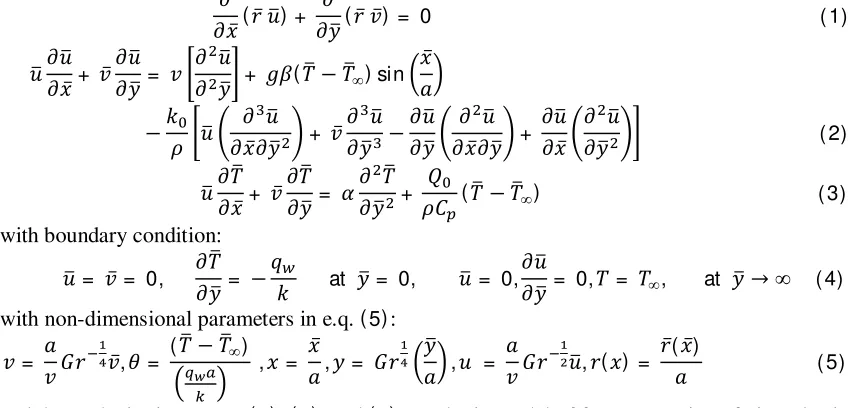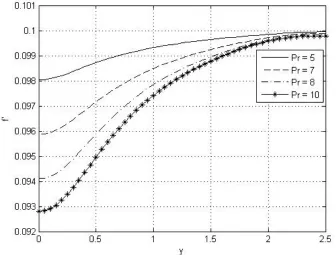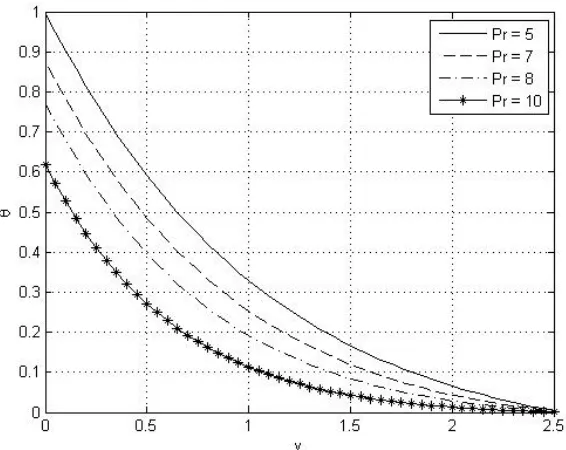M – 15
THE NUMERICAL SOLUTION OF FREE CONVECTION FLOW
OF VISCOELASTIC FLUID PAST OVER A SPHERE
Wayan Rumite1, Basuki Widodo2, Chairul Imron3
Department of Mathematics, Faculty of Mathematics and Natural Sciences, Sepuluh Nopember Institute of Technology, Surabaya
1
[email protected], [email protected], and 3
Abstract
Free convection flow is heat transfer on fluid caused by buoyancy forces because of density difference. We further use The boundary layer theory to obtain governing equations. The governing equations are further transformed into non-dimensional and then transformed into the non-similar governing equation. The non-similar governing equations are solved numerically by using explicit finite difference method. The numerical results are analyzed correlation viscoelastic and Prandtl number with velocity and temperature profile. Based on the numerical results of free convection flow of viscoelastic fluid past over a sphere, we obtained that the velocity profile decreases when we apply the increasing in the values of viscoelastic and Prandtl number. The temperature profiles increases with the increasing in the values of viscoelastic, but decreases when the values of Prandtl number increases.
Keywords: Navier-Stokes, Explicit Finite Difference Method, Viscoelastic, Prandtl number Mathematics Subject Classification: 65C20, 65M06, 76A10, 76D05, 76D10
INTRODUCTION
Heat transfer is the transfer of energy from one object to another due to temperature differences between the two objects. Generally, the heat transfer process is divided into three, i.e. conduction, convection, and radiation. Convection heat transfer is the transfer of heat from a place to another caused by the movement of fluid. Heat transfer by convection is divided into two, i.e. free and forced convection. Free convection is the transfer heat caused by buoyancy forces because of the differences in density. When a fluid exposed to heat, the fluid will expand and its density will change such that the fluid move. Part of the fluid exposed to heat, its density will becomes smaller so that the fluid move to the top and turn into a cooler fluid, then the cold fluid that its density is greater than the top will move down. Forced convection is heat transfer occurs because forced by external forces.
These last few years, topics of free convection flow specifically have been developed
by several researchers such as Molla, et al., (2006), Salleh, et al., (2010b). Taher (2005)
examines natural convection boundary layer flow on an isothermal sphere in presence of heat generation, assuming incompressible flow in a state then resolved by using the finite difference method Keller box. Prasad, et al., (2011) examines unsteady free convection heat and mass
viscoelastic type, incompressible, thermal power plants, and with the completion of an explicit
Non-Newtonian fluid is a fluid whose viscosity changes when there are forces acting on the fluid. This causes the viscosity of non-Newtonian fluid is not constant. Non-Newtonian fluid has several types such as: solid plastic, exponential fluid, and viscoelastic fluid. Examples of non-Newtonian fluids in their daily lives, such as paint, metal composite materials, bitumen, dough, nylon, lubricating oil, sludge, blood, liquid pharmaceuticals, pulp, etc. Viscoelastic fluid is a type of non-Newtonian fluid that viscous and elastic. Examples of these fluids are bitumen, dough, nylon, etc. Viscoelastic fluid applied in oil drilling, food and paper industry. This probem solved by using mathematical model derived from the boundary layer equations. Boundary layer is a thin layer which is near the solid surface, caused by the viscousity of fluid flow on the solid surface. Boundary layer equations are simplified from complex equations, then use for describing the characteristic of a flow. The equations derived from boundary layer equations, i.e. continuity, momentum, and energy equations.
RESEARCH METHOD
Research methods developed for accomplishing the problem free convection of viscoelastic fluid past over a sphere as below.
Constructing mathematical modeling free convection of viscoelastic fluid past over a sphere
of mass, second Newton’s, and thermodynamics conservation law.
Determining boundary condition and several related parameters such like viscoelastic
number ( ), Prandtl number ( ), heat generation ( ), and Grashof number ( ).
Getting the mathematical model consisting of continuity, momentum, and energy equations
in dimensional equations form.
Transforming mathematical modeling dimensional into non-dimensional form, then into
similar form.
Discretization of similar mathematical modeling using Forward in Time and Centered in
Space and than create a simulation program based on the discretization by using
softwere MATLAB 2012b.
Finding the effect viscoelastic ( ) and Prandtl number ( ) parameters on velocity profile
( ′) and temperature profile ( ) at lower stagnation point ( ≈0).
MATHEMATICALMODELLING
Figure 1. shows shape geometry of the boundary layer problems in spherical coordinate system. The flow of fluid is assumed to move across the surface of a sphere with radius
immersed in a viscous and incompressible fluid. The ambient temperature is ∞ and assumed
that the heat flux from the surface of the sphere is . Mathematical modeling free convection
of viscoelastic fluid past over a sphere as below.
and than substitution to e.q. ( 1), ( 2), and ( 3) we obtain model of free convection of viscoelastic
fluid past over a sphere in non-dimensional form, such as e.q. ( 6), ( 7), and ( 8).
where and is viscoelastic and Prandtl number parameter, and is Grashof number and
heat generation defined as:
and than substitution to e.q. ( 11) we obtain model of free convection of viscoelastic fluid past
− + 1 + cos Then by applying the Gauss Seidel iteration method in equation (18), we obtained:
RESULTANDDISCUSSION
The results obtained from simulation are the effect of viscoelastic parameters ( ) and
Prandtl number ( ) to the velocity profile ( ’) and temperature profile ( ).
Figure 2. Velocity Profile with respect to the thickness and various
Figure 4. Temperature Profile with respect to the thickness and various
Figure 5. Temperature Profile with respect to the thickness and various
( ~ ), so the Prandtl number of parameters also directly proportional to the coefficient of
viscosity of the fluid ( ~ ).
Based on the results of the graph in Figure 4, the viscoelastic parameters versus proportional to the temperature profile. The increasing of viscoelastic parameter causes the increasing of the temperature profile. This is because the more viscous fluid that past over a sphere, the greater the friction between the fluid and sphere surface, then the greater fluid temperature becomes. Figure 5 describes the effect of Prandtl numbers to temperature profile. The increasing of Prandtl number causes the decreasing of the temperature profile. This is because Prandtl numbers shows temperature distribution on the free convection flow past over a sphere.
CONCLUSION
The numerical results of free convection flow of viscoelastic fluid past over a sphere indicate that the velocity profile decreases when we apply the increasing in the values of viscoelastic and Prandtl number. The temperature profiles increases with the increasing in the values of viscoelastic, but decreases when the values of Prandtl number increases.
ACKNOWLEDGMENT
Author is grateful to Prof. Dr Basuki Widodo, M.Sc. and Dr. Chairul Imron, MI.Komp. for their guidance and advice that has been given during the writing of this article and to LPPM Sepuluh Nopember Institute of Technology that has helped for defrayed this research.
REFFERENCES
Causon, D.M. dan Mingham, C.G. (2010). Introductory Finite Difference Methods for PDEs,
Departement Of Computing and Mathematics, UK.
Hoffmann, Klaus A. dan Chiang, Steve T. (2000), Computitational Fluid Dynamics,
Engeneering Education System, USA.
Jafarpur, K. dan Yovanovich, M.M. (1992), ”Laminar Free Convective Heat Transfer From
Isothermal Spheres: A New Analytical Method”, Vol. 35, No. 9, hal. 2195-2201.
Kasim, A.R.M. (2014), Convective Boundary Flow of Viscoelastic Fluid, Disertasi Ph.D.,
Universiti Teknologi Malaysia, Malaysia.
Kreith, Frank. (1994), Prinsip-Prinsip Perpindahan Panas, Edisi Ketiga, Erlangga, Jakarta.
Lienhard, J.H. (2002), A Heat Transfer Textbook, Third Edition, Phlogiston Press,USA.
Munson, B.R., Young, D.F., dan Okiishi, T.F. (2003), Mekanika Fluida, Edisi Keempat,
Erlangga, Jakarta.
Potter, Merlec C. dan Wiggert, David C. (2008). Mekanika Fluida, Erlangga, Jakarta.
Salleh, M. Z. dan Nazar, R. (2010), Modeling of Free Convection Boundary Layer Flow on a
Sphere with Newtonian Heating, Acta Appl. Math., 112: 263–274.
Streeter, Victor L., Wyle, E. Benjamin, dan Prijno, Arko. (1988), Mekanika Fluida, Edisi
Taher, M.A., Molla, M.M. (2005), ”Natural Convection Boundary Layer Flow On An
Isothermal Sphere in Presence Of Heat Generation”, Proceedings of the 5th IMEC 10th
and APM, Dhaka.
Tonekaboni, S.A.M.,Akbar, R., dan Khoeilar, R. (2011), ”On the Study of Viscoelastic
Walters B Fluid in Boundary Layer Flows”, Vol. 2012, hal. (18).


